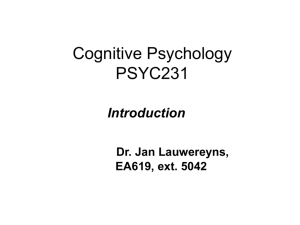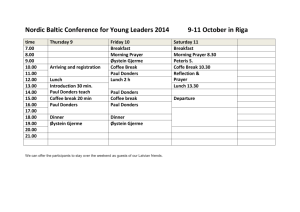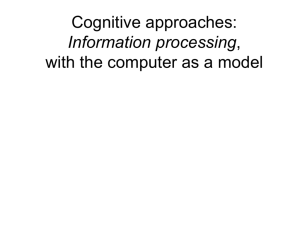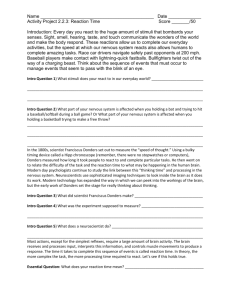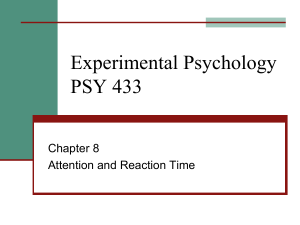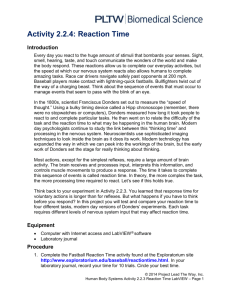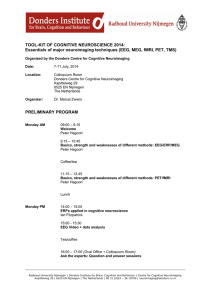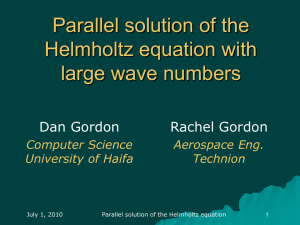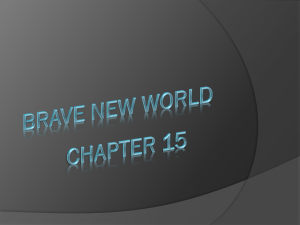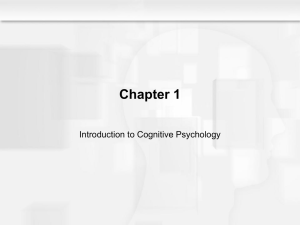14-准备时间与简单反应时
advertisement
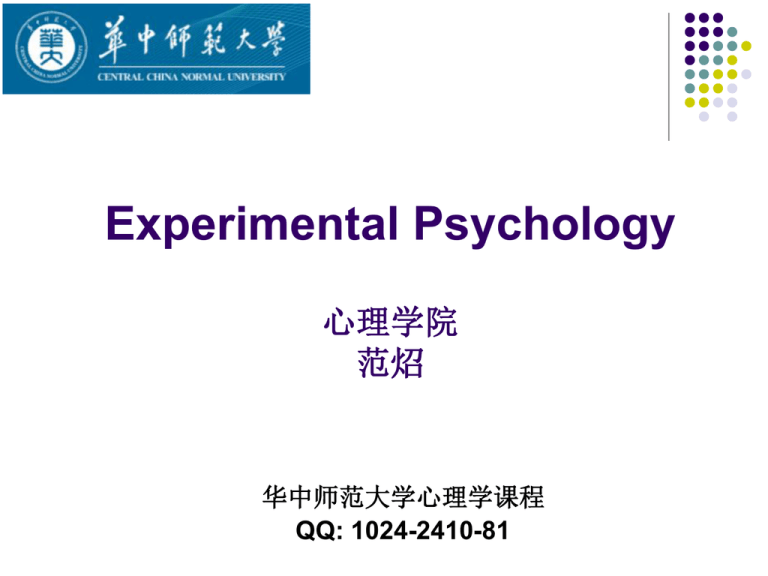
Experimental Psychology 心理学院 范炤 华中师范大学心理学课程 QQ: 1024-2410-81 Attention and Reaction Time: • Early RT Study: • In an early RT experiment (1851), Helmholtz measured the speed of the nervous impulse, showing how to implement experimental techniques on psychological topics. [Stimulated blindfolded people on either the shoulder or the ankle and measured how fast they could react with their hand (by pushing a lever) in each case; around 50m/s, around 26m/s for frog nerve] The sensory physiology of Helmholtz was the basis of the work of Wilhelm Wundt (1879 first psychology lab), a student of Helmholtz. Hermann Ludwig Ferdinand von Helmholtz (1821 – 1894), German physician and physicist Attention and Reaction Time: • Donders – Subtractive method: • 1868, Donders, a Dutch physiologist, realized he could use people’s reaction times to calibrate the time required for various mental operations. • Designed three RT tasks that are still called Donders A, B, and C reactions, Figure 8.1. Donders A RT: simply RT Perhaps providing a baseline of the cognitive operations. Donders B RT: choice RT A (Baseline Time) + Identification + (Response) Selection Donders C RT: discriminative RT Two stimuli but only one is linked to a response. 反应时:不是指执行反应的时间,而是指刺激 施于有机体之后,到明显反应开始所需要的时 间; Attention and Reaction Time: • Donders – Subtractive method: Donders – Subtractive method: Figure 8.2 C-A = Stimulus Identification Time; B-C = Selection Time 减法反应时方法最初被用 来测定某一心理过程所需 的时间. 但反过来看,因为心理过 程总是需要花费时间的, 所以也可以从某两个反应 时的差别,推断某一个心 理过程的存在。 20世纪中期兴起来的认知 心理学正是这样来应用减 法反应时方法的,它在认 知心理学中的位置非常重 要。 准备时间与简单反应时: 实验目的: 了解不同的准备时间对于简单反应时的影响 。 简介: 简单反应时是指一个刺激出现,要求被试从看到或听到刺激到立即作出反 应的这段时间间隔,由于该反应时是感知到刺激就立即作出反应,中间没有其 它的加工过程,因此也被称为基线时间。准备时间则指的是从发出预备信号到 刺激呈现之间的时间,也称为前期(foreperiod)。研究证明,不给预备信号 比给预备信号反应时要长。如果给预备信号,准备时间的长短与反应速度也有 关系。如果在准备信号发出后紧接着就呈现刺激,被试就来不及准备,不能迅 速反应。如果准备时间太长,被试又会注意涣散,也不能做出迅速的反应。 C.W.Telford曾采用听觉刺激对29个未受训练的被试进行过试验,结果发现1-2s 的准备时间的反应时比5s和4s的要短些。一般说来,最优的准备时间大体上在 2s左右。 准备时间与简单反应时: 方法与程序: 本实验的实验任务有两种:视觉任务和听觉任务。实验时屏幕上先呈现一 个“+”的预备信号,一段准备时间后呈现刺激,要求被试迅速作出反应。视觉 任务中刺激物为绿圆,听觉任务中刺激物为单音。 实验程序设置有三种准备时间:1s、2s和6s。任务安排按照ABBA方式,其 中A为视觉任务,B为听觉任务。每个任务单元中,每种准备时间呈现8次,共 24个试次,顺序随机。每个试次中,屏幕上先呈现预备信号“+”,时间为 500ms,500ms后“+”消失,间隔一段随机化(可能为0.5s、1.5s或5.5s)的时 间后再呈现任务刺激,呈现时间为1s。要求被试在刺激呈现后迅速按相应键作 反应,记录其反应时。 如果测试中被试在准备阶段即刺激呈现之前作出反应,则该次反应无效, 计算机将警告抢码被试,并重新进行测试。 实验过程中每个任务单元结束后休息30秒,再开始下一次。 准备时间与简单反应时: 结果与讨论: 分别统计在视觉任务和听觉任务中,不同准备时间下的简单反应时,同时 系统还提供上述情况下反应时的折线图。 试根据实验结果图讨论准备时间对简单反应时的影响以及不同任务条件下 这种影响是否具有一致性。 名词解释: 准备时间:指的是从发出预备信号到刺激呈现之间的时间,也称为前期 (foreperiod)。 简单反应时:又称a反应时,指的是在测试中呈现的刺激和要求被试做出的 反应都只有一个,且固定不变。
